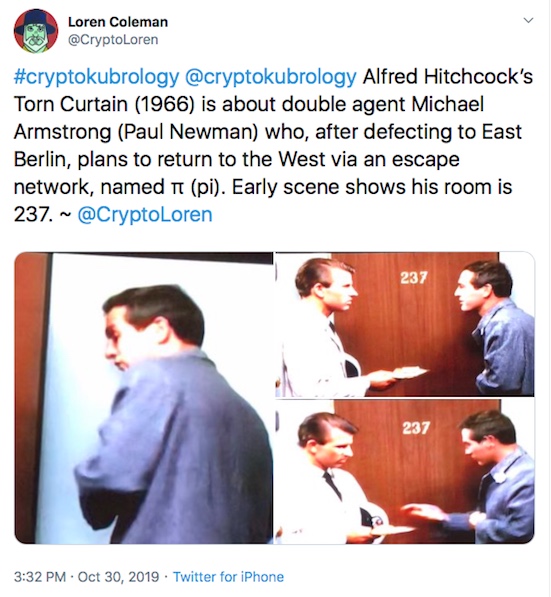Cryptokubrology: "A useful methodology for deconstructing cinema, history, and synchronicity." ~ says Alex Fulton (@Crypto-Kubruology), January 31, 2017.
Cryptokubrology has been defined as "digging through the works of Stanley Kubrick on the premise that its body is a muted mass of coded cabalistic ministrations comparable (in scope) to the works of William Shakespeare, but incomparable (in complexity) to anything in recorded history. In fact, Cryptokubrology has led to an entirely different view of so-called 'history' itself." ~ says Robert Shawn Montgomery (shawnfella)
The work in this realm has come in the wake of The Shining, of course. One of the foundation analyses is Room 237.
As the New York Times stated in 2013, "Like The Shining and its maze within a maze, Mr. Ascher’s movie is something of a labyrinth."
The film was produced by Tim Kirk. The title refers to a room in the haunted hotel featured in The Shining, which a character is warned never to enter. Ascher had a budget of $5,426, and made $296, 359 at the box office. It was a sterling success in the history of documentary film.
Another filmmaker who has studied the craft of Kubrick is Gary Leva.
Leva Filmworks' "Stanley Kubrick Collection" includes (each link has a clip from his selection) the following:
Fulton and Montgomery have produced a series of YouTube videos:
Who said "237"?
The best evidence for finding true cryptokubrological insights may come from concentrating on the pre-The Shining examples.
The Crypto-K series gives incidents of "237" being found in films. But as opposed to hundreds or thousands of instances, the series only mentions 31 films or television episodes where the number 237 is mentioned or shown (for example as an address or room number). Of those, I find Fulton and Montgomery include only ten instances of pre-1980 cases of "237."
I have found others, such as in Torn Curtain (1966).
But let us look at those that Fulton and Montgomery cite in their videos from before and up to 1980. From watching their series, here is their complete list. These are enhanced with some of their screenshots, and revealed thus far (unless I missed any) where "237" specifically appears:
Possessed (1931)
Shop Around The Corner (1940)
Possessed (1947)
In the Good Old Summertime (1949)
The Three Faces of Eve (1957)
Sleeper (1973)
Sleeper (1976)
The Big Bus (1976)
The World Beyond (1978)
The Shining (released May 23, 1980)
The Blues Brothers (released June 20, 1980; filming occurred July to October 1979)
Other Cryptokubrology Essays




























1 comment:
Good article, I was just talking to Alex about how Judy Garland climbs 237 steps in her final film: I Could Go on Singing (1963) where she plays Jenny Bowman.
Just after 21 minutes into the film
So that's a nice bookend to Garland's 237 saga.
Post a Comment